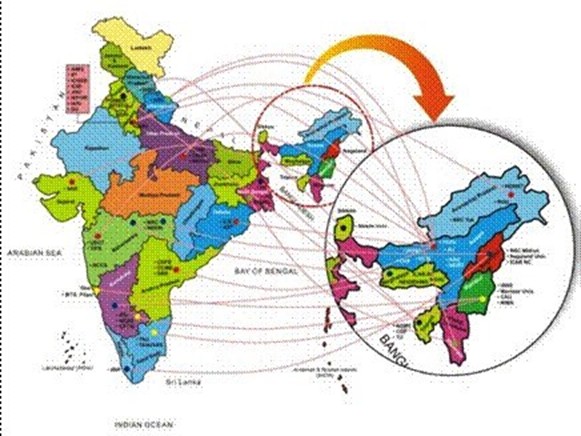Content:
- Biodiversity to Bioeconomy
- Ministry of Mines classifies Barytes, Felspar, Mica and Quartz as Major Minerals
Biodiversity to Bioeconomy
Context & Importance of Biotechnology in NER
- North East Region (NER) of India: Rich in biodiversity, cultural heritage, and natural resources.
- Biotechnology acts as a catalyst for:
- Sustainable economic growth
- Preservation of natural and cultural heritage
- Employment generation through bio-entrepreneurship
- Climate-resilient agriculture and health innovations
Relevance : GS 2(Governance ) , GS 3(Environment and Ecology)
Department of Biotechnology’s (DBT) North Eastern Programme
- Budget Allocation: Since 2010, 10% of DBT’s annual budget allocated to NER-focused programmes.
- Objectives:
- Harness endemic bioresources
- Promote biotech education and research
- Create local employment via bio-based enterprises

Major Programmes Under NER
A. Capacity Building & Education Initiatives
- Twinning R&D Programme (2010-11):
- Collaboration between 65+ NER institutions & leading national institutes
- Supported ~650 R&D projects, benefiting ~450 researchers and 2000 students
- Biotech Hubs (Since 2011):
- Established 126 hubs across NER for biotech research and education
- Phase-II: 54 hubs focusing on local issues and specialized research
- Biotechnology Labs in Senior Secondary Schools (BLiSS) (2014):
- Established labs to cultivate biotech interest at school level
- Visiting Research Professorship (VRP) Programme (2015):
- Leveraged expertise of eminent scientists to uplift local biotech education
- Specialized Training Programmes:
- Chemical Ecology Programme (2015): Tailored training for PhD and postdoc researchers with institutes like NCBS, IISc.
- Genomics-Driven Research in Human Health (2016):Comprehensive workshops for biomedical research, molecular genetics, and clinical sample handling.
B. Agriculture & Farmers-Focused Initiatives
- DBT-North East Centre for Agricultural Biotechnology (NECAB) – Phase III:
- Enhanced services to farmers; supported research on crop resilience and productivity
- Citrus Research & Development:
- Established facilities at Institute of Horticulture Technology, Assam
- Developed disease-free rootstocks for Khasi mandarin and sweet orange
- Medicinal Plant Cultivation:
- Cultivated 64.1 acres with crops like Curcuma caesia and high-value lemongrass
- Trained 649 farmers and entrepreneurs in sustainable farming practices
- Value Addition to Indigenous Fruits:
- Explored Docynia indica (Assam apple) for products like jams, pickles, and juices
- Conducted awareness campaigns in tribal communities of Assam and Meghalaya
Major Achievements & Innovations
- Agricultural Innovations:
- Bacterial Blight-resistant Rice Variety “Patkai“:
- Developed by Assam Agricultural University
- Combines resistance with flood tolerance (Ranjeet Sub1 background)
- Bacterial Blight-resistant Rice Variety “Patkai“:
- Veterinary & Livestock Innovations:
- Lateral Flow Assay (LFA) for Brucellosis Detection:
- Rapid detection tool with high sensitivity for livestock disease management
- Lateral Flow Assay (LFA) for Brucellosis Detection:
- Digital & Technological Solutions:
- Pig Disease Diagnosis Expert System (PDDES):
- Mobile app aiding pig disease diagnosis
- Available on Google Playstore; improves veterinary outreach and farm productivity
- Pig Disease Diagnosis Expert System (PDDES):
Broader Impacts & Sustainable Growth
- Biodiversity Preservation:
- Sustainable use of medicinal and indigenous plant resources
- Economic Upliftment:
- Boost in local income via bio-entrepreneurship and product diversification
- Educational Empowerment:
- Enhanced research opportunities and skill development in biotechnology
- Environmental Sustainability:
- Focus on eco-friendly agriculture and disease-resistant crops
- Community Engagement:
- Active involvement of farmers, tribal communities, and students in biotech projects
Way Forward
- Strengthen partnerships between local institutions and national/global biotech leaders
- Expand biotech solutions in healthcare, agriculture, and environmental sustainability
- Foster community–driven bio–entrepreneurship for long-term economic resilience
Ministry of Mines classifies Barytes, Felspar, Mica and Quartz as Major Minerals
Background and Policy Context
- Notification: Issued by the Ministry of Mines on 20th February 2025 through a gazette notification.
- Reclassification: Minerals Barytes, Felspar, Mica, and Quartz moved from minor to major minerals category.
- Policy Alignment: Follows the National Critical Mineral Mission approved by the Union Cabinet on 29th January 2025, aimed at self-reliance in critical minerals.
Relevance : GS 3(Mines and Minerals)
Rationale Behind Reclassification
- Critical Minerals Exploration:
- Quartz, Felspar, and Mica are found in pegmatite rocks—rich sources of critical minerals like Lithium, Beryl, Niobium, Tantalum, Tin, Titanium, Tungsten.
- Baryte is associated with ores of Antimony, Cobalt, Copper, Lead, Manganese, and Silver.
- Under-Reporting Issue:
- Under minor mineral leases, critical minerals were overlooked as the focus was on using primary minerals for construction, glass, ceramics, etc.
- Leaseholders did not declare or extract associated critical minerals, leading to loss of strategic resources.
- Economic and Strategic Significance:
- Critical minerals are vital for:
- Energy transition technologies (e.g., lithium for batteries)
- Spacecraft industries (lightweight, heat-resistant materials)
- Healthcare sector (advanced diagnostic devices)
- Critical minerals are vital for:
- Baryte’s use in oil and gas drilling, radiation shielding, electronics, and construction materials underscores its industrial relevance.
Implications of Major Mineral Classification
- Enhanced Regulation and Exploration:
- Mines to be regulated by the Indian Bureau of Mines (IBM) for scientific mining practices.
- Increased exploration expected due to stricter compliance and higher investment incentives.
- Lease Period Extension:
- Existing leases will not be adversely affected.
- Major mineral leases: Extended up to 50 years under Section 8A of the MMDR Act, 1957.
- Revenue and Federal Dynamics:
- Revenue sharing pattern unchanged; states continue to accrue mining revenues.
- Transition Period:
- Four-month window provided until 30th June 2025 for operational adjustments.
Key Benefits of the Move
- Strategic Autonomy:
- Reduces dependence on imports of critical minerals crucial for energy and technology sectors.
- Resource Optimization:
- Promotes co-mining of associated minerals, ensuring better resource utilization.
- Boost to Industries:
- Enhances the supply chain for renewable energy, electronics, defense, and healthcare industries.
- Environmental Considerations:
- Scientific mining practices to reduce environmental degradation and improve sustainability.
Challenges and Considerations
- Operational Readiness:
- Mines and leaseholders must adapt to stricter IBM compliance norms.
- Environmental and Social Concerns:
- Scaling exploration may pose ecological challenges; needs careful Environmental Impact Assessments (EIA).
- Capacity Building:
- States and private players need to upgrade mining technology and exploration techniques.
Way Forward
- Focus on Sustainable Mining: Balance economic gains with environmental protection and community welfare.
- Promote Innovation: Encourage use of advanced mining technologies for efficient resource extraction.
- Enhance Private Sector Participation: Attract investments through policy stability and ease of doing business measures.
- Monitor Critical Mineral Supply Chains: Develop strategies for long-term mineral security to support India’s energy and technological ambitions.



